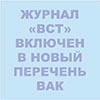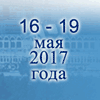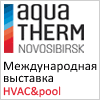Number 12 / 2016
To download all number in format PDF (in Russian)The further text is accessible on a paid subscription.
For authorisation enter the login/password.
Or subscribe
Number maintenance (pdf) (doc)
Number abstract (doc)
Literature lists to articles (doc)
Index of the Articles (doc, pdf), Published in the Water Supply and Sanitary Technique Magazine in 2016.
|
bbk 000000
УДК
Strelkov A. K., Shuvalov M. V., Stepanov S. V.
«EKOS» Research and Production Company – the partner of the Department of water supply and wastewater disposal of SSTU in training of highly qualified personnel
|
| Read more... |
bbk 000000
UDC 628.16.027:628.543
Egorova Yu. A., Kichigin V. I., Nesterenko O. I.
Study of the chemical and physical composition of raw water at the pumping-filtration stations of Samara
Summary
The results of the study of physical, chemical and bacteriological composition of the raw water at the pumping-filtration stations in Samara for the period of 2011–2015 are presented. The limits of water quality variation by 53 indicators were determined. It was proved that the actual BOD/COD ratios were significantly lower compared to the critical value 0.5, i. e. the incoming raw water at the pumping-filtration stations in Samara contained mainly resistant to oxidation inorganic matter requiring physical and chemical treatment. It was shown that the microbiological quality of the incoming raw water at PFS-1 was worse compared to the raw water quality at PFS-2. The statistically reliable values of the physical and chemical indicators of the raw water at the water intakes in Samara were determined that provided for establishing an automated data base in «Samarskie Kommunal’nye Sistemy» LLC for predicting the required modes of drinking water purification.
Key words
water intake , raw water , pumping station , water quality prediction , reagent
|
| Read more... |
bbk 000000
UDC 168.165
Tsabilev O. V., Strelkov A. K.
Optimization of the scheme of preparing demineralized water at the existing machine building enterprise
Summary
Machine building industry needs demineralized water for moisturizers, washing and other processes. To prepare demineralized water the method of reverse osmosis is used. The advantages of this method of water demineralization are as follows: low chemical consumption, compact size of the plants and possible flexibility of the process automation. Considering the scale of reverse osmosis use and diversity of the solvable problems designing a versatile installation meeting all the requirements is practically impossible and economically unjustified. It is evident that engineering calculations and design adaptation shall be carried out in each case. An example of upgrading the demineralization scheme with the purpose of improving the capacity and conditioned water quality is presented. The result is achieved by the use of the two-stage reverse osmosis scheme that provides for the minimum chemical costs during the operation. The modernization of the facilities was carried out in continuous-duty service. Half year operation of the upgraded two-stage scheme the sustained quality of the demineralizaed water has been observed.
Key words
two-stage scheme , water demineralization , membrane module , reverse osmosis , permeate
|
| Read more... |
bbk 000000
УДК 628.179
Strelkov A. K., Biriukov V. V., Egorova Yu. A., Zaiko V. A., Bykova P. G.
Analysis and assessment of water distribution network failures in Samara
Summary
The main task of the water distribution network maintenance and operation service is improving the quality and reliability of supplying water to the customers. The analysis of the water distribution network state in the urban district of Samara showed that the majority of the pipelines had been significantly depreciated. This is caused by fact that they were laid and put into operation during the period of large-scale housing construction (1960–1980-ies) without due account of the requirements to the durability of the materials applied and technical and organizational capacity of the operating companies. According to the statistics lately the rate of failures in the water distribution networks has been gradually but sustainably reducing. The assessment of the data on the operation and maintenance of the water distribution networks showed 22% reduction of the total number of failures in 2015 compared to 2013; accordingly water losses also decreased. Achieving these results was possible due to the timely repair and maintenance works in 2013–2015.
Key words
breakdown rate , water supply network , pipe material , pipeline failure , water leaks
|
| Read more... |
bbk 000000
UDC 628.31:661.5
MOROZOVA K. M., Stepanov S. V., Stepanov A. S., Sokolova T. V., Solkina O. S., Zhukova M. A.
Biological treatment of dairy industry wastewater in a membrane bioreactor (part 1)
Summary
The results of research study in the field of biological treatment of dairy wastewater are presented. The studies carried out under contact conditions showed that the kinetics of oxidation of dairy wastewater pollutants with activated sludge can be described by enzymatic reactions equation for substrate inhibition; at that, the obtained inhibition constants point at the increase of the wastewater toxicity after chemical flotation for biological treatment processes. The technology has been proved with simulative effluent in a pilot membrane bioreactor. The kinetic dependences of organics oxidation by BODfull, nitrification and denitrification were determined. The increase of oxidation capacity of the facilities by 1.46 at the sludge concentration increase from 4 to 10 g/l is shown that allows reducing significantly the size of the biological treatment facilities when using MBR technology. In the course of experimental studies at MBR plant and kinetic experiments under contact conditions the coefficients of inhibition with activated sludge metabolism products were determined for the simulative solution of wastewater by BODfull, for nitrification and denitrification. The temperature constant value for aerobic heterotrophic conversion, for nitrification and denitrification processes has been found.
Key words
activated sludge , biological treatment , kinetic constants , membrane bioreactor , dairy factory , wastewater
|
| Read more... |
bbk 000000
UDC 628.29/.31
Shuvalov M. V., Strelkov A. K., Shuvalov S. V., Tarakanov D. I.
Designing the project of surface runoff treatment facilities in Samara
Summary
The results of developing design and engineering documentation of the main intercepting sewer and treatment facilities for surface runoff from the drainage area of the Volga downhill of Samara are presented. The runoff produces a negative impact on the river intake of the two main municipal pumping-filtration stations. Designing and constructing these projects are implemented within the frames of the high-priority activities envisaged by the Master Plan of Samara approved in 2008. The route of the main rainwater sewer approved in the project provides for the possible connection of eleven outfalls discharge untreated surface runoff into gulleys of the Volga downhill. The process of surface runoff treatment envisages four stage water treatment with flow rate and pollutant concentration equalization in accumulating tanks: the first stage – mechanical treatment (screening, sedimentation in grit chambers and accumulating tanks); the second stage – physical and chemical treatment (coagulation of pollutants, sedimentation in laminar settling tanks); the third stage – enhanced treatment (filtration in contact clarifiers, two-stage filtration in sorption filters with MIU-S media); the fourth stage – UV water disinfection.
Key words
treatment facilities , intercepting sewer , surface runoff , rain water system
|
| Read more... |
bbk 000000
UDC 628.311
Palagin E. D., Strelkov A. K., Bykova P. G., Tsypin A. V., Vdovin D. V.
Rainfall parameters for the calculation of the capacity of surface runoff treatment facilities
Summary
The summarized data on the maximum depth of the rainfall that is completely removed to the treatment facilities (like the runoff from the group 1 residential and industrial areas in big cities of the Russian Federation) is presented. The analysis of the revealed regularities was carried out. The calculated values of the rainfall depth obtained in the course of observations at 87 meteorological stations on the territory of the Russian Federation are needed for calculating the capacity of the surface runoff treatment facilities and can be used in the process of making designs for settlements where the data of the meteorological stations is representative. The rainfall depth that provides for removing at least 70 % of the annual rainfall to the treatment facilities in most cases corresponds to the upper limit of the recommended range of 5–10 mm.
Key words
meteorological station , rainfall volume , surface runoff , precipitation depth , distribution function
|
| Read more... |
bbk 000000
UDC 504.06
Bykova P. G., Palagin E. D., Gridneva M. A.
Determining the dilution ratio in wastewater discharge regulation
Summary
Wastewater dilution is used for reducing the concentration of pollutants in water bodies and water courses. The intensity of dilution process is quantified by the dilution ratio that equals to the ratio of the sum of the rate of wastewater flow and water medium to the wastewater flow rate or equals to the ratio of excess pollution concentration at the outfall to the similar concentrations in the considered cross-section. The method of calculating the wastewater dilution ratio at the discharge to water courses from point and diffusing sources is presented. The results of the calculations for several options of the reference conditions are set. The limitations of using different methods are described. The necessary adjustments and recommendations are given for calculating the total wastewater dilution with account of the initial one.
Key words
water course , dilution ratio , discharge regulation , diffusing and point outfalls , wastewater
|
| Read more... |
bbk 000000
UDC 628.1/.3.196
GALPERIN E. M.
The complexity of the reliability index of water and wastewater facilities
(to be discussed)
Summary
Reliability has been the most important feature of water and wastewater facilities. However no clear consistent definition of this notion and the procedure of calculating its indicators have been formulated so far. At present it can be done only with use the mathematical tool of the reliability theory. Most of the published editions on that subject offer one of the failure-free performance parameters as a reliability index without considering the fact that water and wastewater facilities are maintainable. Hereof it follows the need of using the integrated reliability index that takes into account both failure-free performance and maintainability. For the calculation of this index Markov model with continuous-time discrete state is used.
Key words
failure-free performance , simple index , integrated reliability index , Markov model , repairability , water and wastewater systems
|
| Read more... |
|











